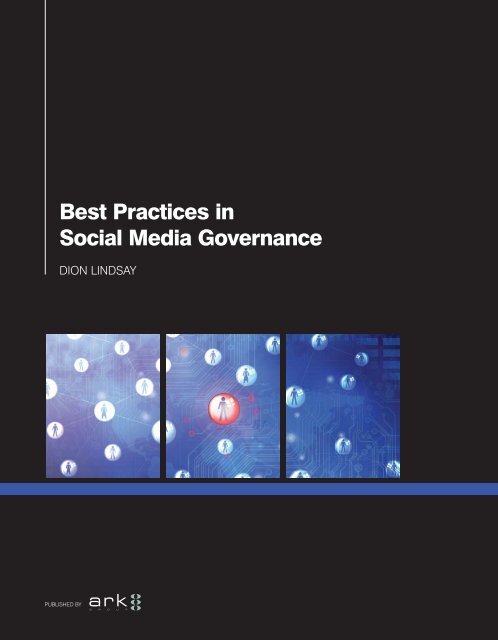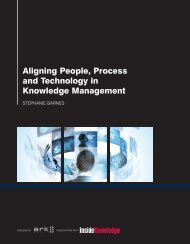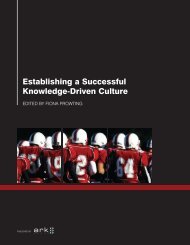Best Practices in Social Media Governance
Best Practices in Social Media Governance - Ark Group
Best Practices in Social Media Governance - Ark Group
- No tags were found...
You also want an ePaper? Increase the reach of your titles
YUMPU automatically turns print PDFs into web optimized ePapers that Google loves.
<strong>Best</strong> <strong>Practices</strong> <strong>in</strong><br />
<strong>Social</strong> <strong>Media</strong> <strong>Governance</strong><br />
DION LINDSAY<br />
PUBLISHED BY
<strong>Best</strong> <strong>Practices</strong> <strong>in</strong> <strong>Social</strong> <strong>Media</strong> <strong>Governance</strong><br />
UK/EUROPE OFFICE<br />
Ark Conferences Ltd<br />
Paulton House<br />
8 Shepherdess Walk<br />
London N1 7LB<br />
United K<strong>in</strong>gdom<br />
Tel +44 (0)207 549 2500<br />
Fax +44 (0)20 7324 2373<br />
publish<strong>in</strong>g@ark-group.com<br />
NORTH AMERICA OFFICE<br />
Ark Group Inc<br />
4408 N. Rockwood Drive<br />
Suite 150<br />
Peoria IL 61614<br />
United States<br />
Tel +1 309 495 2853<br />
Fax +1 309 495 2858<br />
publish<strong>in</strong>gna@ark-group.com<br />
ASIA/PACIFIC OFFICE<br />
Ark Group Australia Pty Ltd<br />
Ma<strong>in</strong> Level<br />
83 Walker Street<br />
North Sydney NSW 2060<br />
Australia<br />
Tel +61 1300 550 662<br />
Fax +61 1300 550 663<br />
aga@arkgroupasia.com<br />
Onl<strong>in</strong>e bookshop<br />
www.ark-group.com/bookshop<br />
Editor<br />
Evie Serventi<br />
eserventi@ark-group.com<br />
Head of content<br />
Anna Shaw<br />
ashaw@ark-group.com<br />
UK/Europe market<strong>in</strong>g enquiries<br />
Robyn Macé<br />
rmace@ark-group.com<br />
US market<strong>in</strong>g enquiries<br />
Daniel Smallwood<br />
dsmallwood@ark-group.com<br />
Asia/Pacific market<strong>in</strong>g enquiries<br />
Steve Oesterreich<br />
aga@arkgroupasia.com<br />
ISBN: 978-1-908640-23-9 (hard copy)<br />
978-1-908640-24-6 (PDF)<br />
Copyright<br />
The copyright of all material appear<strong>in</strong>g with<strong>in</strong><br />
this publication is reserved by the author and<br />
Ark Conferences 2012. It may not be reproduced,<br />
duplicated or copied by any means without the<br />
prior written consent of the publisher.<br />
ARK2053
<strong>Best</strong> <strong>Practices</strong> <strong>in</strong><br />
<strong>Social</strong> <strong>Media</strong> <strong>Governance</strong><br />
DION LINDSAY<br />
PUBLISHED BY
Contents<br />
Executive summary ............................................................................................................. V<br />
About the author and contributors .....................................................................................VII<br />
Acknowledgements ............................................................................................................IX<br />
Part One: A primer <strong>in</strong> social media governance<br />
Chapter 1: What is social media? ....................................................................................... 3<br />
Just how big is social media <strong>in</strong> the UK? .................................................................................. 3<br />
Chapter 2: Why govern social media? ................................................................................ 7<br />
What is governance? ............................................................................................................ 7<br />
The benefits of social media .................................................................................................. 7<br />
The risks of social media ....................................................................................................... 8<br />
What does governance entail? ............................................................................................... 9<br />
Chapter 3: The legal context – Protect<strong>in</strong>g your IP on the <strong>in</strong>ternet ...................................... 11<br />
The UK perspective ............................................................................................................. 11<br />
The US perspective ............................................................................................................. 12<br />
Law and governance ........................................................................................................... 13<br />
Data protection .................................................................................................................. 14<br />
Chapter 4: <strong>Governance</strong> structures and documentation ..................................................... 15<br />
Creat<strong>in</strong>g the structure .......................................................................................................... 15<br />
Achiev<strong>in</strong>g the right balance ................................................................................................. 16<br />
<strong>Governance</strong> documents ...................................................................................................... 17<br />
Risk versus reward – Sett<strong>in</strong>g examples .................................................................................. 20<br />
Communicat<strong>in</strong>g the policy ................................................................................................... 20<br />
Resources ........................................................................................................................... 21<br />
Chapter 5: Creat<strong>in</strong>g a social media policy ........................................................................ 23<br />
By Lee Hopk<strong>in</strong>s<br />
Do we really need a social media policy? ............................................................................. 23<br />
Employees – The case for a social media policy .................................................................... 26<br />
Writ<strong>in</strong>g your own social media policy ................................................................................... 27<br />
III
Contents<br />
Who should create our social media policy? ......................................................................... 28<br />
Conclusion ......................................................................................................................... 29<br />
Chapter 6: Manag<strong>in</strong>g social media participation .............................................................. 31<br />
‘Herd<strong>in</strong>g cats’ – How to encourage without strangl<strong>in</strong>g creativity ............................................. 31<br />
Tra<strong>in</strong><strong>in</strong>g users and manag<strong>in</strong>g expectations ............................................................................ 32<br />
Skills and tra<strong>in</strong><strong>in</strong>g for new and exist<strong>in</strong>g staff .......................................................................... 33<br />
Instill<strong>in</strong>g values ................................................................................................................... 36<br />
Dos and don’ts ................................................................................................................... 36<br />
Chapter 7: Manag<strong>in</strong>g social media impact ....................................................................... 39<br />
Supportive, disruptive and transformative trends .................................................................... 39<br />
Monitor<strong>in</strong>g ......................................................................................................................... 39<br />
Def<strong>in</strong><strong>in</strong>g success: Return on <strong>in</strong>vestment (ROI) and impact analysis .......................................... 40<br />
Part Two: <strong>Social</strong> media governance <strong>in</strong> practice – Case studies and example policies<br />
Case study 1: Dom<strong>in</strong>o’s Pizza ........................................................................................... 45<br />
Case study 2: The Johnson & Johnson Motr<strong>in</strong> advertisement ............................................ 47<br />
Case study 3: Dell ........................................................................................................... 49<br />
Case study 4: ChapStick ................................................................................................... 51<br />
Example policy 1: BBC...................................................................................................... 53<br />
Example policy 2: The American Institute of Architects ...................................................... 61<br />
Example policy 3: IBM ...................................................................................................... 65<br />
Index ...............................................................................................................................71<br />
IV
Executive summary<br />
THE USE of social media by enterprises is<br />
now an established fact: few organisations<br />
with market<strong>in</strong>g ambitions will ignore the<br />
potential benefits of hav<strong>in</strong>g a presence on<br />
Twitter, Facebook and L<strong>in</strong>kedIn, and the<br />
conclusions that their customer base will<br />
draw if they are absent from these arenas.<br />
Nevertheless social media presents<br />
an unfamiliar environment for external<br />
communication departments, one where<br />
traditional models of controll<strong>in</strong>g the content<br />
and distribution of messages to the outside<br />
world no longer hold sway. Participation <strong>in</strong><br />
the social media world is an <strong>in</strong>stantaneous<br />
activity, not one underp<strong>in</strong>ned by thorough<br />
research <strong>in</strong>to cause and effect, return on<br />
<strong>in</strong>vestment or risk management.<br />
Highly publicised adverse <strong>in</strong>cidents<br />
chart the dangers of misread<strong>in</strong>g the social<br />
media environment: over-reactions to<br />
angry post<strong>in</strong>gs and failure to respond to<br />
criticism have both had harsh effects on<br />
the commercial reputation of companies,<br />
and the strategies they have formed <strong>in</strong> the<br />
wake of such <strong>in</strong>cidents have been costly to<br />
ma<strong>in</strong>ta<strong>in</strong> with little assurance of success.<br />
At the same time, enterprises see<br />
the results of positive stories or images<br />
go<strong>in</strong>g viral on social media and lust<br />
after the benefits these can br<strong>in</strong>g. In this<br />
‘Wild West’ environment, someth<strong>in</strong>g ak<strong>in</strong><br />
to a gold rush has been form<strong>in</strong>g as<br />
companies create advertis<strong>in</strong>g campaigns<br />
specifically for YouTube and Facebook,<br />
and try to create and protect a positive<br />
presence on Wikipedia.<br />
<strong>Best</strong> <strong>Practices</strong> <strong>in</strong> <strong>Social</strong> <strong>Media</strong><br />
<strong>Governance</strong> maps this environment,<br />
document<strong>in</strong>g the nature of social media, its<br />
uptake, and the benefits and risks <strong>in</strong>volved <strong>in</strong><br />
participation for your organisation. These are<br />
illustrated with case studies and examples<br />
of social media policies and guidel<strong>in</strong>es.<br />
Above all, the report addresses the need<br />
for governance with<strong>in</strong> organisations, and<br />
what it might take to ma<strong>in</strong>ta<strong>in</strong> control of<br />
participation at the same time as allow<strong>in</strong>g<br />
freedom for benefits to accrue <strong>in</strong> <strong>in</strong>tr<strong>in</strong>sically<br />
unpredictable and uncontrollable ways.<br />
Follow<strong>in</strong>g an <strong>in</strong>troduction to the basic<br />
pr<strong>in</strong>ciples and current scope of social media<br />
<strong>in</strong> the work environment <strong>in</strong> Chapter 1,<br />
Chapter 2 demonstrates the need for<br />
governance <strong>in</strong> this context, <strong>in</strong>clud<strong>in</strong>g a<br />
summary of the standards and resources<br />
that should be <strong>in</strong> place <strong>in</strong> order to establish<br />
a successful strategy. Chapter 3 covers the<br />
legal considerations relevant to social media<br />
governance, <strong>in</strong>clud<strong>in</strong>g perspectives from<br />
both the UK and the US.<br />
Effective governance requires the<br />
establishment of an <strong>in</strong>ternal structure<br />
for the promotion, management and<br />
monitor<strong>in</strong>g of your social media activities.<br />
Your organisation may also wish to create<br />
governance documents that clearly state<br />
your strategies and policies. Chapter 4<br />
covers these topics <strong>in</strong> detail, demonstrat<strong>in</strong>g<br />
how to <strong>in</strong>tegrate your policies with exist<strong>in</strong>g<br />
organisational strategies, encourage<br />
top level buy-<strong>in</strong> and ensure that your<br />
documentation is fit for purpose. This<br />
V
Executive summary<br />
section <strong>in</strong>cludes practical examples that will<br />
help you to make the best decisions to suit<br />
your organisation’s specific requirements.<br />
In Chapter 5, guest contributor Lee<br />
Hopk<strong>in</strong>s discusses the case for and aga<strong>in</strong>st<br />
a social media policy for your organisation,<br />
and goes on to outl<strong>in</strong>e a strategy for<br />
creat<strong>in</strong>g an effective policy that staff will<br />
actually use and abide by.<br />
Manag<strong>in</strong>g participation <strong>in</strong> social media<br />
activity means balanc<strong>in</strong>g your strategic<br />
objectives with the practical aspects of onl<strong>in</strong>e<br />
communication – <strong>in</strong>clud<strong>in</strong>g the potential<br />
risks fac<strong>in</strong>g social media users. Chapter<br />
6 details practical examples to help you<br />
tra<strong>in</strong> your employees, manage expectations<br />
and <strong>in</strong>stil organisational values <strong>in</strong>to their<br />
activities. This section also <strong>in</strong>cludes helpful<br />
‘dos and don’ts’ which will aid the successful<br />
creation of your social media policies.<br />
Chapter 7 discusses measur<strong>in</strong>g and<br />
manag<strong>in</strong>g the impact of your social media<br />
activity, particularly where additional<br />
expenditure must be justified with a costbenefit<br />
analysis.<br />
Part Two focuses on social media<br />
governance <strong>in</strong> practice, with case studies<br />
and example policies. Four case studies<br />
illustrate the social media problems – and<br />
their solutions – faced by Dom<strong>in</strong>o’s Pizza,<br />
Johnson & Johnson, Dell and ChapStick.<br />
These cautionary tales exemplify the best<br />
and worst approaches to take when faced<br />
with an onl<strong>in</strong>e backlash, and will help you to<br />
put <strong>in</strong> place effective policies for your own<br />
social media activity. They illustrate too how<br />
difficult is to be sure of the ‘right’ approach<br />
to such <strong>in</strong>cidents. Three example social<br />
media policies are <strong>in</strong>cluded, from the BBC,<br />
The American Institute of Architects and IBM,<br />
the latter considered to be a ‘gold standard’<br />
<strong>in</strong> social media governance.<br />
VI
About the author and contributors<br />
Dion L<strong>in</strong>dsay – Author<br />
Dion L<strong>in</strong>dsay is an experienced knowledge manager, consultant and tra<strong>in</strong>er. His UK based<br />
consultancy, Dion L<strong>in</strong>dsay Consult<strong>in</strong>g, works with large charities, membership organisations and the<br />
public and private sectors on knowledge shar<strong>in</strong>g and management strategies. He is also partner <strong>in</strong> a<br />
world wide consultancy for remote collaboration techniques, CyberWorkplace.com.<br />
He writes the well-known <strong>in</strong>tranets column <strong>in</strong> eLucidate, the e-journal for emerg<strong>in</strong>g topics <strong>in</strong><br />
electronic <strong>in</strong>formation management (see http://www.ukeig.org.uk/elucidate), and is a committee<br />
member of its publish<strong>in</strong>g body. He is an experienced workshop facilitator on topics <strong>in</strong>clud<strong>in</strong>g social<br />
media <strong>in</strong> the workplace, for the Ark Group, and <strong>in</strong>tranets, presented with Mart<strong>in</strong> White of Intranet Focus.<br />
Dion can be contacted at dion@dionl<strong>in</strong>dsayconsult<strong>in</strong>g.com.<br />
Lee Hopk<strong>in</strong>s – Contributor<br />
Lee Hopk<strong>in</strong>s is a management psychologist and bus<strong>in</strong>ess communicator with nearly 30 years’<br />
experience <strong>in</strong> help<strong>in</strong>g bus<strong>in</strong>esses communicate better, for better bus<strong>in</strong>ess results.<br />
At the lead<strong>in</strong>g edge of bus<strong>in</strong>ess communicators <strong>in</strong> Australia, Lee understands the transformative<br />
nature of social media. He spends a considerable amount of his time advis<strong>in</strong>g bus<strong>in</strong>esses,<br />
bus<strong>in</strong>ess communities and <strong>in</strong>dividual bus<strong>in</strong>ess communicators on the tectonic cultural shifts that<br />
new communications technology is facilitat<strong>in</strong>g and how they can best position themselves to take<br />
advantage of them.<br />
He is also currently undertak<strong>in</strong>g doctoral research at the University of South Australia’s School of<br />
Communication, look<strong>in</strong>g at how the new social communication landscape has impacted on senior<br />
communicators’ roles and responsibilities.<br />
An <strong>in</strong>ternationally sought-after speaker, Lee comb<strong>in</strong>es his passion for employee and onl<strong>in</strong>e bus<strong>in</strong>ess<br />
communication with his dynamic presentation skills to create ‘once seen, never forgotten’ live experiences.<br />
He has over 200 articles on bus<strong>in</strong>ess communication available for read<strong>in</strong>g at LeeHopk<strong>in</strong>s.com<br />
and blogs, podcasts and vidcasts at LeeHopk<strong>in</strong>s.net. Lee can be contacted at Lee@LeeHopk<strong>in</strong>s.com.<br />
Alex Marks – Contributor<br />
Alex formed Fresh & Frank Consult<strong>in</strong>g <strong>in</strong> 2010, after many years’ experience work<strong>in</strong>g for some of the<br />
world’s largest companies. He recognised that bus<strong>in</strong>ess success is driven from the blend of offl<strong>in</strong>e<br />
and digital, not one over the other; and that clients were look<strong>in</strong>g for grown-up support that had<br />
‘been there and done it’ and had the confidence to tell them what they didn’t want to hear.<br />
He has over 16 years’ agency and client side experience across a broad range of clients and<br />
sectors, <strong>in</strong>clud<strong>in</strong>g retail, telecommunications, broadcast and tourism. He has worked <strong>in</strong>ternationally for<br />
eBay, help<strong>in</strong>g to set up its advertis<strong>in</strong>g bus<strong>in</strong>ess. At Microsoft he was responsible for the UK market<strong>in</strong>g<br />
of its advertis<strong>in</strong>g division, which <strong>in</strong>cluded the successful launch of Microsoft Adcenter <strong>in</strong> 2006.<br />
VII
About the author and contributors<br />
Prior to this Alex worked at digital media agency i-level, where he was market<strong>in</strong>g and new<br />
bus<strong>in</strong>ess director. He has also worked <strong>in</strong> traditional media for companies such as Capital Radio,<br />
Classic FM, and Zenith <strong>Media</strong>.<br />
He is a published author, a regular commentator, writer and conference speaker on digital<br />
market<strong>in</strong>g issues and a key blogger for The Market<strong>in</strong>g Society. His <strong>in</strong>terests <strong>in</strong>clude music, runn<strong>in</strong>g<br />
and box<strong>in</strong>g, all of which he regularly still <strong>in</strong>dulges despite his recent realisation that he might be<br />
gett<strong>in</strong>g a bit old for all this.<br />
Alex can be contacted at alex@freshandfrank.co.uk.<br />
VIII
















